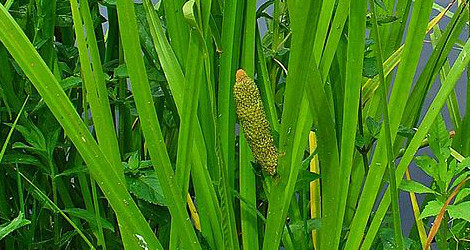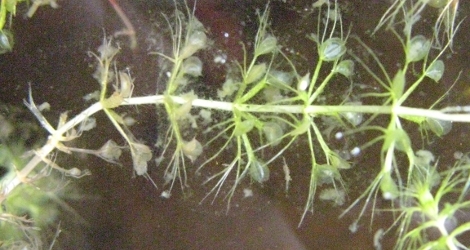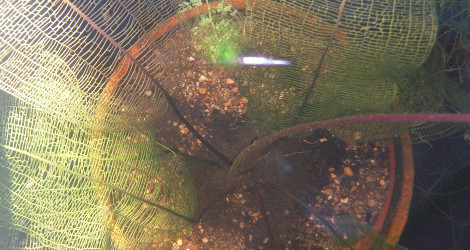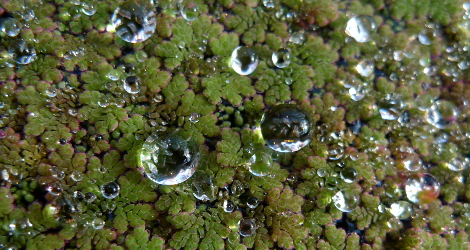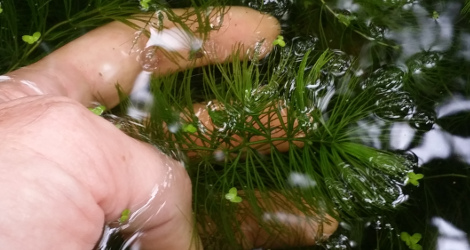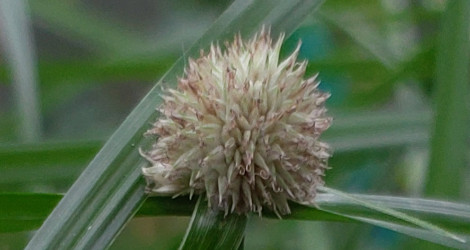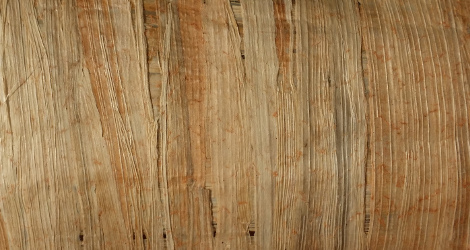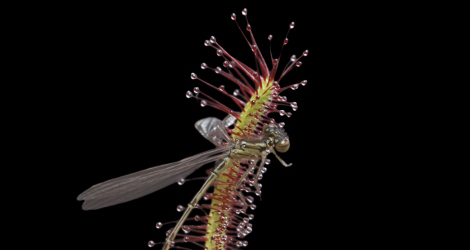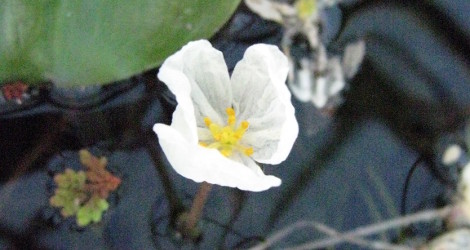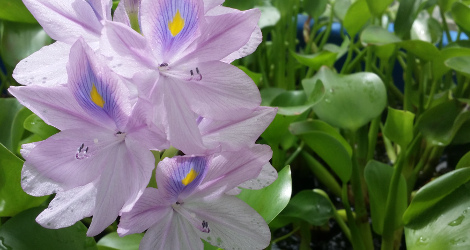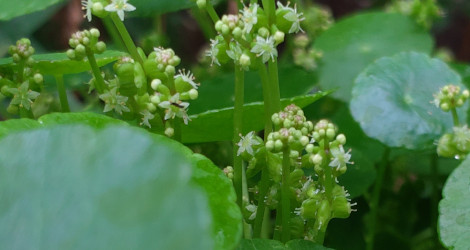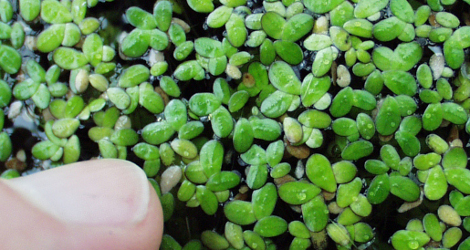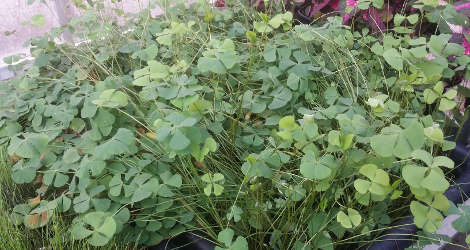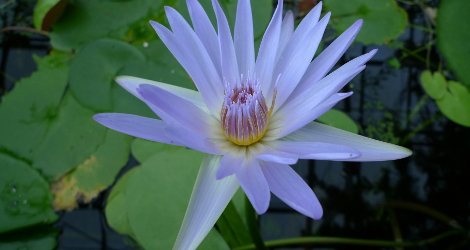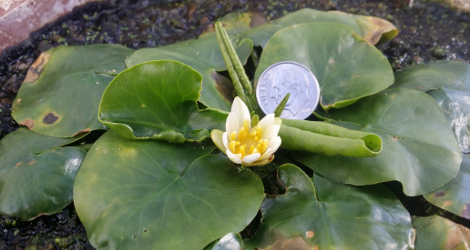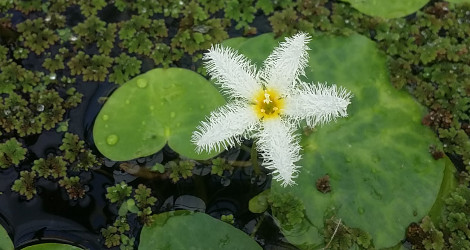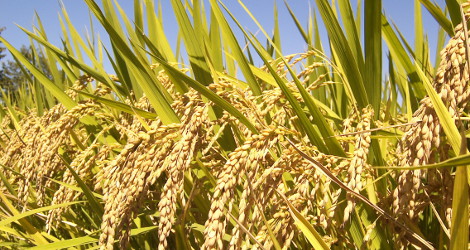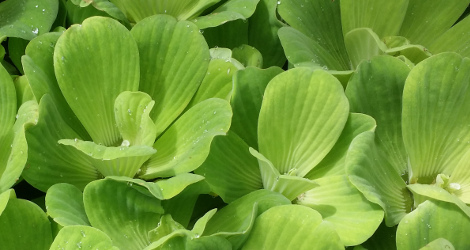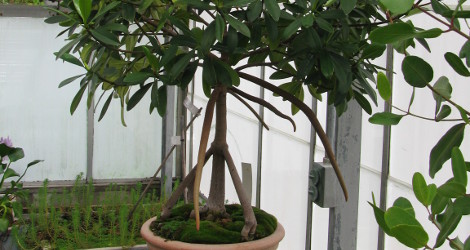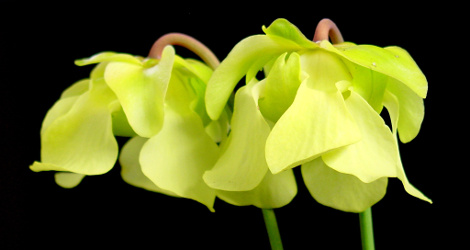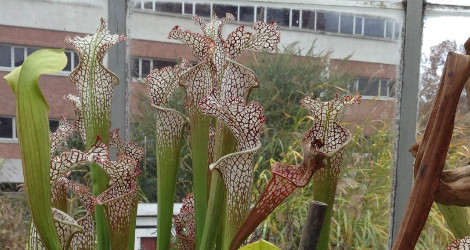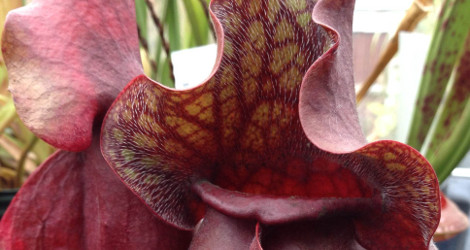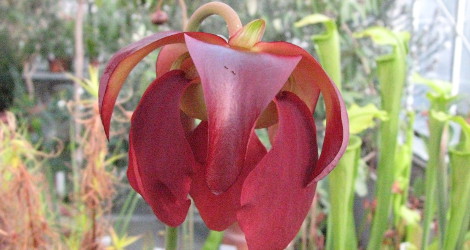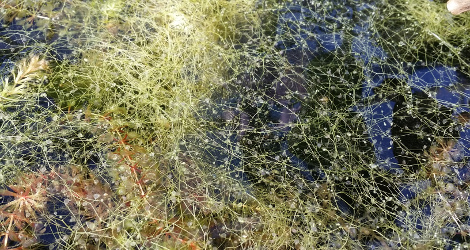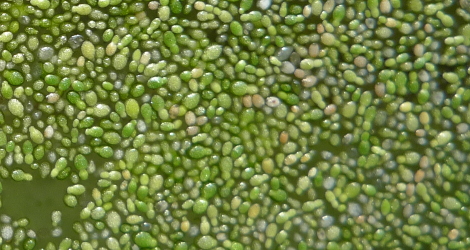SPECIAL COLLECTION:
Aquatic Plants
 but borderline cases exist, such as Sarracenia (the North American pitcher plants), which grow rooted in wet soil that might not always be completely saturated, a habitat which some authors might consider not to be truly aquatic.
but borderline cases exist, such as Sarracenia (the North American pitcher plants), which grow rooted in wet soil that might not always be completely saturated, a habitat which some authors might consider not to be truly aquatic.
Plants with adaptations to aquatic habitats have arisen in numerous unrelated lineages.
 The majority of species are angiosperms (flowering plants), but there are also specialized aquatic mosses and liverworts, some conifers that are confined to wetland habitats like Chamaecyparis thyoides (Atlantic White Cedar), aquatic ferns like Azolla and Ceratopteris, as well as a genus of aquatic lycopods, Isoetes.
The majority of species are angiosperms (flowering plants), but there are also specialized aquatic mosses and liverworts, some conifers that are confined to wetland habitats like Chamaecyparis thyoides (Atlantic White Cedar), aquatic ferns like Azolla and Ceratopteris, as well as a genus of aquatic lycopods, Isoetes.
Aquatic plants can be divided into several subgroups based on their growth habit and ecology. Benthophytes refers to plants that are rooted into the substrate. Submergent benthophytes like Elodea have leaves that grow completely below the water surface.
 Planmergent benthophytes like Nymphaea (water lilies) produce leaves that float at the surface. Emergent benthophytes are plants such as Typha (cattails) have self-supporting leaves and stems that grow above the water surface.
Pleustophytes are aquatic plants that float unattached to any solid substrate, in some cases lacking roots entirely. Acropleustophytes, or free-floating aquatics, are buoyant and float at the water surface (e.g. Wolffia or Pistia). Mesopleustophytes, a.k.a. suspended aquatics, such as the Humped Bladderwort, Utricularia gibba, drift submerged in the water column.
Planmergent benthophytes like Nymphaea (water lilies) produce leaves that float at the surface. Emergent benthophytes are plants such as Typha (cattails) have self-supporting leaves and stems that grow above the water surface.
Pleustophytes are aquatic plants that float unattached to any solid substrate, in some cases lacking roots entirely. Acropleustophytes, or free-floating aquatics, are buoyant and float at the water surface (e.g. Wolffia or Pistia). Mesopleustophytes, a.k.a. suspended aquatics, such as the Humped Bladderwort, Utricularia gibba, drift submerged in the water column.
The ecological constraints on aquatic plants are often radically different from those that act on terrestrial plants, and aquatics have evolved a number of specialized adaptations to watery habitats. Submerged leaves are thin or finely dissected (e.g. Ceratophyllum), with a very high surface area to volume ratio, in order to facilitate gas exchange, which is much slower in water than in air. Submerged leaves also show anatomical and physiological adaptations to low light levels, since sunlight intensity drops off rapidly with increasing water depth.
 Aquatic plants of marine environments, including mangroves like Rhizophora, may have glands on their leaves to secrete excess salt.
Aquatic plants of marine environments, including mangroves like Rhizophora, may have glands on their leaves to secrete excess salt.
The stems, roots and leaves of many aquatic plants contain aerenchyma, spongy tissue that contains unusually large air spaces. Some acropleustophytes, such as Eichhornia (Water Hyacinth), use aerenchyma for flotation.
 Often, the function of aerenchyma seems to be the transport of gasses. Emergent or planmergent benthophytes move oxygen from their leaves and the atmosphere through aerenchyma down to their roots, which enables the roots to function in anoxic sediments. Conversly, carbon dioxide from the roots can diffuse through aerenchyma to the leaves, where it is used for photosynthesis.
Often, the function of aerenchyma seems to be the transport of gasses. Emergent or planmergent benthophytes move oxygen from their leaves and the atmosphere through aerenchyma down to their roots, which enables the roots to function in anoxic sediments. Conversly, carbon dioxide from the roots can diffuse through aerenchyma to the leaves, where it is used for photosynthesis.
NOTE: Some of the aquatic plants in the collections are considered invasive and are not kept on display in public areas. Those needing access to restricted material for research or teaching should inquire with the greenhouse staff.
References:
- Bell, A.D. 1991. Plant Form. Oxford University Press, Oxford, New York, Tokyo.
- Fassett, N.C. 1985. A Manual of Aquatic Plants. University of Wisconsin Press, Madison, Wi.
- Les, D.H. 2003. Aquatic Plants. Magill's Encyclopedia of Science: Plant Life volume 1. Pp. 82-84. B.D. Ness, ed. Salem Press, Pasadena, Ca, Hackensack, NJ.
Greenhouse Locator Map:
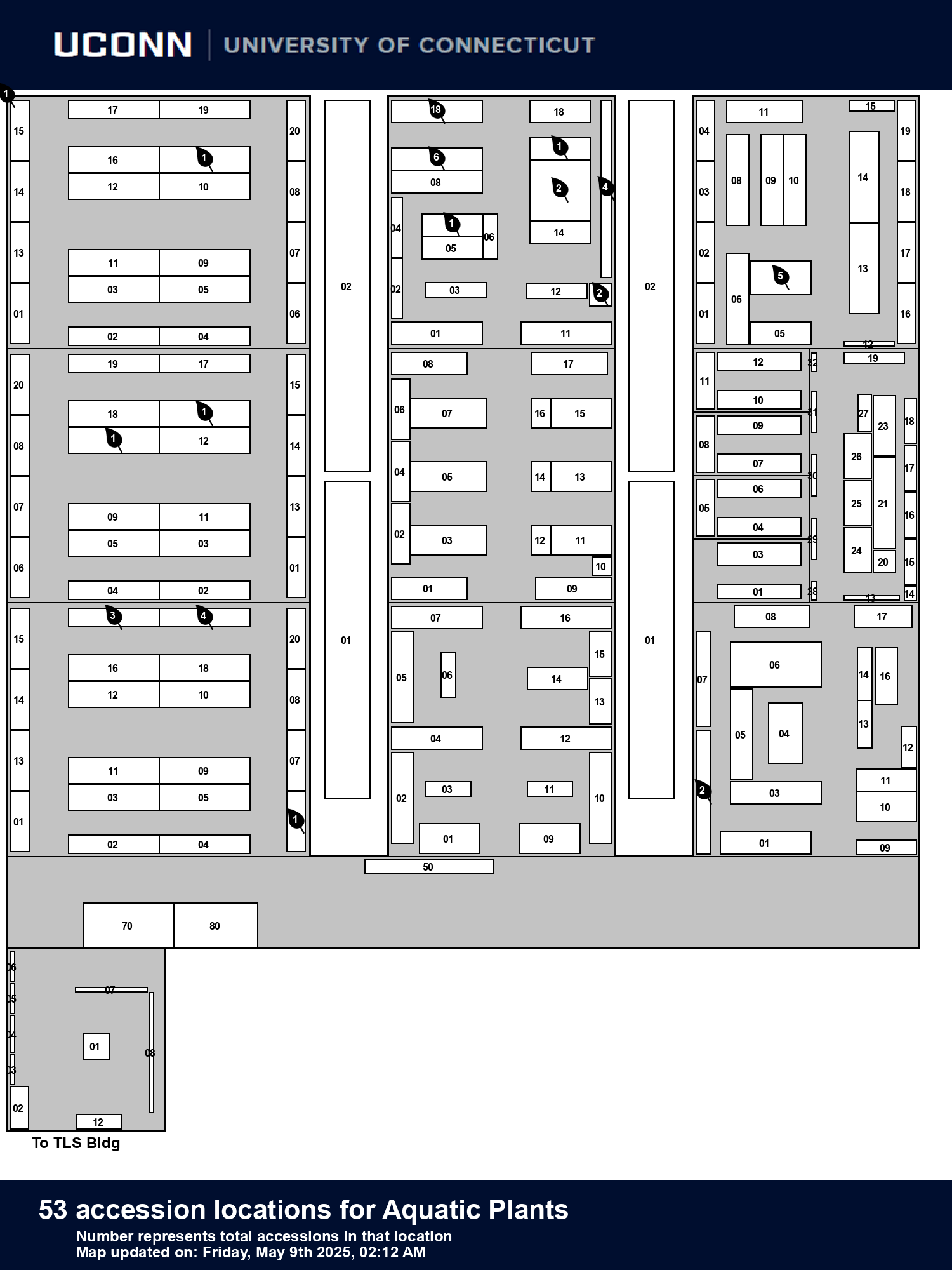
data regenerated on Sat, 26 Jul 2025 02:12:08 -0400
63 Accessions:
Number in parentheses references locator map icons
- {0} Limnobium laevigatum - Amazon Frogbit, South American Spongeplant - Hydrocharitaceae
- {1} Nymphaea thermarum - Pygmy Rwandan Water Lily - Nymphaeaceae

 W/C
W/C - {2} Cyperus alternifolius - Umbrella Plant - Cyperaceae


- {2} Hydrocotyle verticillata - Water Pennywort - Araliaceae


- {2} Zantedeschia aethiopica - Calla Lily, Lily of the Nile - Araceae


- {3} Cyperus brevifolia - shortleaf spikesedge, green kyllinga - Cyperaceae


- {3} Cyperus diffusus - Dwarf Umbrella Grass - Cyperaceae


- {3} Cyperus papyrus - Papyrus - Cyperaceae


- {3} Rhizophora mangle - Red Mangrove - Rhizophoraceae


- {4} Colocasia esculenta - Taro - Araceae

- {5} Oryza sativa - Asian Rice cv. Taipei 309 - Poaceae


- {6} Ceratophyllum demersum - Coontail - Ceratophyllaceae


- {7} Chamaecyparis thyoides - Atlantic White Cedar - Cupressaceae W/C
- {8} Drosera capensis - Cape Sundew - Droseraceae

 W/C
W/C - {8} Neobeckia aquatica - Brassicaceae W/C
- {8} Oxypolis filiformis subsp. greenmanii - Apiaceae
- {8} Sarracenia alata - Pale Pitcher Plant - Sarraceniaceae

 W/C
W/C - {8} Triglochin maritima - Seaside arrowgrass - Juncaginaceae
 W/C
W/C - {8} Xyris caroliniana - Carolina Yellow-eyed Grass - Xyridaceae

- {9} Aldrovanda vesiculosa - Waterwheel Plant - Droseraceae

 W/C
W/C - {9} Gratiola aurea - Golden Hedge Hyssop - Plantaginaceae W/C
- {9} Hippuris vulgaris - Mare's Tail - Plantaginaceae
- {9} Lemna minor - Common Duckweed - Araceae


- {9} Menyanthes trifoliata - Bog Buckbean, Marsh Trefoil - Menyanthaceae
 W/C
W/C - {9} Sarracenia alata - Pale Pitcher Plant - Sarraceniaceae

 W/C
W/C - {9} Sarracenia alata - Pale Pitcher Plant - Sarraceniaceae

 W/C
W/C - {9} Sarracenia flava - Yellow Pitcher Plant - Sarraceniaceae


- {9} Sarracenia flava var. flava - Yellow Pitcher Plant, Huntsman's Horn - Sarraceniaceae
 W/C
W/C - {9} Sarracenia flava var. rubricorpa - Sarraceniaceae

- {9} Sarracenia leucophylla - White Top Pitcher Plant - Sarraceniaceae


- {9} Sarracenia minor - Hooded Pitcher Plant - Sarraceniaceae

- {9} Sarracenia oreophila - Green Pitcher Plant - Sarraceniaceae
 W/C
W/C - {9} Sarracenia psittacina - Parrot Pitcher Plant - Sarraceniaceae


- {9} Sarracenia purpurea - Purple Pitcher Plant - Sarraceniaceae


- {9} Sarracenia rosea - Burk's Southern Pitcher Plant - Sarraceniaceae

- {9} Sarracenia rubra ssp. alabamensis - cane-break pitcher plant - Sarraceniaceae
- {9} Sarracenia rubra ssp. jonesii - Mountain Sweet Pitcher Plant - Sarraceniaceae

 W/C
W/C - {10} Elodea canadensis - Canadian waterweed, broad waterweed, American el - Hydrocharitaceae

- {10} Wolffia columbiana - Common Wolffia - Araceae


- {11} Azolla caroliniana - Mosquito Plant - Salviniaceae


- {11} Ornduffia reniformis - Running Marsh Flower - Menyanthaceae

- {12} Acorus calamus - Sweet Flag - Acoraceae


- {13} Isoetes sp. - Quillwort - Isoetaceae
- {13} Nymphoides indica - Menyanthaceae

- {13} Typha laxmannii - Graceful Cattail - Typhaceae

- {13} Utricularia gibba - Humped Bladderwort - Lentibulariaceae

- {14} Marsilea drummondii - Nardoo - Marsileaceae
- {14} Marsilea quadrifolia - European Water Clover - Marsileaceae


- {15} Ceratopteris pteridoides - Water Sprite - Pteridaceae
- {15} Eichhornia crassipes - Water Hyacinth - Pontederiaceae


- {15} Myriophyllum aquaticum - Parrots Feather, Water Feather - Haloragaceae

- {15} Pistia stratiotes - Water Lettuce, Shellflower - Araceae


- {15} Salvinia auriculata - Eared Watermoss - Salviniaceae


- {0} Sarracenia purpurea ssp. purpurea - Purple Pitcher Plant - Sarraceniaceae W/C
- {0} Nymphoides indica - Menyanthaceae
- {0} Spirodela polyrhiza - Greater Duckweed - Araceae
- {0} Brasenia schreberi - Water Shield - Cabombaceae W/C
- {0} Egeria densa - Brazilian Elodea - Hydrocharitaceae

 W/C
W/C - {0} Aponogeton madagascariensis - Madagascar Laceleaf - Aponogetonaceae


- {0} Butomus umbellatus - Flowering Rush - Butomaceae

- {0} Salvinia molesta - Giant Salvinia - Salviniaceae

- {0} Utricularia vulgaris subsp. macrorhiza - Common Bladderwort - Lentibulariaceae

 W/C
W/C - {0} Nymphaea nouchali var. caerulea - Blue Water Lily - Nymphaeaceae


W/C = Wild Collected
 = Currently Flowering
= Currently Flowering = Image(s) Available
= Image(s) Available = map available for this accession
= map available for this accession
 = voucher(s) on file at CONN for this accession
= voucher(s) on file at CONN for this accession = accession added within past 90 days
= accession added within past 90 days
